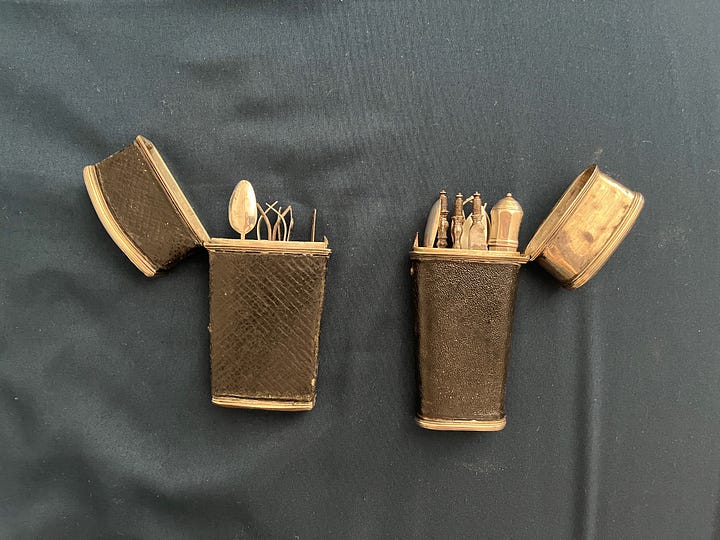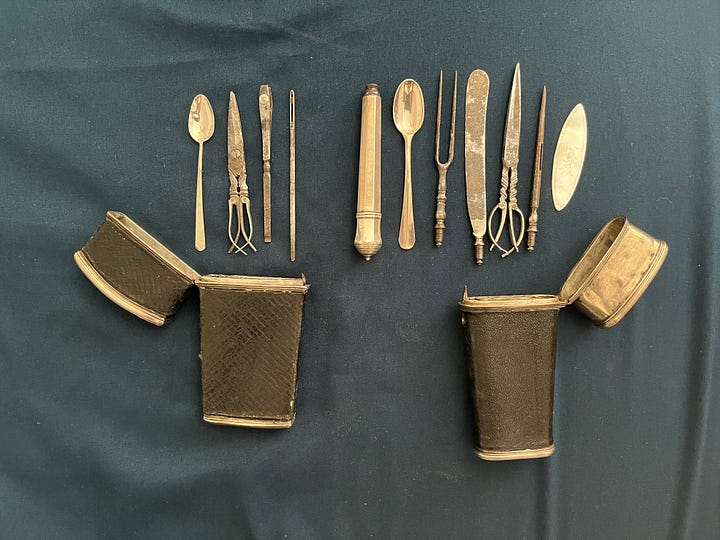Pocket Gadgets and Collecting String
Plus odds and ends I found interesting, fun, or both.


Last year, in the early days of this newsletter, I posted this entry on my fascination with Adam Smith’s musings about pocket gadgets. The occasion for that post was an article I’d written about 18th-century pocket globes. The occasion for this one is a fuller discussion, for Reason’s issue marking the 300th anniversary of Smith’s birth. In it I delve into other 18th-century pocket gadgets—notably étuis like the ones pictured above—and how Smith spun his consideration of them into a broader meditation on the allure of intricate systems. Here’s the opening, to which I’ve added links that will take you to examples:
Pocket gadgets were all the rage in Adam Smith's day. Their popularity inspired one of the most paradoxical, charming, and insightful passages in his work.
The best known are watches. A pocket timepiece was an 18th century man's must-have fashion accessory, its presence indicated by a ribbon or bright steel chain hanging from the owner's waist, bedecked with seals and a watch key. Contemporary art depicts not just affluent people but sailors and farm workers sporting watch chains. One sailor even wears two. "It had been the pride of my life, ever since pride commenced, to wear a watch," wrote a journeyman stocking maker about acquiring his first in 1747.
Laborers could buy watches secondhand and pawn them when they needed cash. A favorite target for pickpockets, "watches were consistently the most valuable item of apparel stolen from working men in the eighteenth century," writes historian John Styles, who analyzed records from several English jurisdictions.
But timepieces were hardly the only gizmos stuffing 18th century pockets, especially among the well-to-do. At a coffeehouse, a gentleman might pull out a silver nutmeg grater to add spice to his drink or a pocket globe to make a geographical point. The scientifically inclined might carry a simple microscope, known as a flea glass, to examine flowers and insects while strolling through gardens or fields. He could gaze through a pocket telescope and then, with a few twists, convert it into a mini-microscope. He could improve his observations with a pocket tripod or camera obscura and could pencil notes in a pocket diary or on an erasable sheet of ivory. (Not content with a single sheet, Thomas Jefferson carried ivory pocket notebooks.)
The coolest of all pocket gadgets were what antiquarians call etuis and Smith referred to as "tweezer cases." A typical 18th century etui looks like a slightly oversized cigarette lighter covered in shagreen, a textured rawhide made from shark or ray skin. The lid opens up to reveal an assortment of miniature tools, each fitting into an appropriately shaped slot. Today's crossword puzzle clues often describe etuis as sewing or needle cases, but that was only one of many varieties. An etui might contain drawing instruments—a compass, ruler, pencil, and set of pen nibs. It could hold surgeon's tools or tiny perfume bottles. Many offered a tool set handy for travelers: a tiny knife, two-pronged fork, and snuff spoon; scissors, tweezers, a razor, and an earwax scraper; a pencil holder and pen nib; perhaps a ruler or bodkin. The cap of a cylindrical etui might separate into a spyglass.
Read the whole thing here.
Odds and Ends from Around the Web
I enjoyed this informative conversation about Nvidia between Jordan Schneider, of the excellent China Talk, and semiconductor watcher Doug O’Laughlin, of Fabricated Knowledge. Here’s a lovely observation from Schneider:
How absurd and beautiful is it that a company built to allow teenagers to play video games and render Wolfenstein ends up being the thing that ushers in an entire industrial revolution? There’s something wonderful and human about how our just wanting to play more realistic games has ended up turning into this incredible thing that’s going to change the lives of not just gamers, but everyone.
Reminds me of the play chapter in The Future and Its Enemies, which arose in part by thinking about what neocons got wrong (back when “neocon” a foreign-policy pejorative but a whole school of thought).
Levi’s says its robots did 25,000 hours of work at “tedious tasks” last year. Here’s an article I wrote in 2018 about Levi’s announcement that it would start distressing jeans using lasers rather than hand labor.
Writing Fellowship Opportunity: The Roots of Progress is offering a great opportunity for aspiring writers interested in progress studies. The Roots of Progress Blog Building Intensive is an 8-week online program designed to build skills, knowledge, and regular writing habits, ending with a three-day in-person program in San Francisco. All expenses paid. More info on the program and how to apply here.
I’m an Amazon Affiliate, so if you’re doing Prime Day shopping, I’ll get a small cut of if you start here. I don’t remember when I signed up, but I do know that I enrolled Reason about five minute after the program was announced. Every penny counts.

